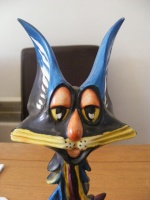World's maddest cat figure - Silvio Righetto, Guido Cacciapuoti, Italy
3 posters
Page 1 of 1

vanmann-
 Number of posts : 616
Number of posts : 616
Location : essex, UK
Registration date : 2010-04-19
 Re: World's maddest cat figure - Silvio Righetto, Guido Cacciapuoti, Italy
Re: World's maddest cat figure - Silvio Righetto, Guido Cacciapuoti, Italy
Can't make out the mark, but the colours remind me of Italian pottery
_________________
Carrot cake is just fake cake
 Re: World's maddest cat figure - Silvio Righetto, Guido Cacciapuoti, Italy
Re: World's maddest cat figure - Silvio Righetto, Guido Cacciapuoti, Italy
Just spotted another one on ebay.uk (sheffield), but still no ID. They haven't bothered to post a photo of the signature or stamp underneath, but their description reads "Signed but hard to read, also stamped underneath possibly says MadeinItaly." 
https://pin.it/yf4Xf3b
https://pin.it/9aMlIPm

https://pin.it/yf4Xf3b
https://pin.it/9aMlIPm
_________________
Carrot cake is just fake cake
 Re: World's maddest cat figure - Silvio Righetto, Guido Cacciapuoti, Italy
Re: World's maddest cat figure - Silvio Righetto, Guido Cacciapuoti, Italy
Whoa! You have a rare piece of "Cacciapuoti" Italian caramics! Your cat was made by Silvio Righetto at the Cacciapuoti manufactory in Milan in the mid-50's. It's a collector's piece $$.
Go here, click on "archivo" in their menu. Then click on the picture for S. RIGHETTO. Then on page 2 and you'll see your kitty!
CACCIAPUOTI Ceramics
The History and Biography of Ceramic e Gres D'Arte Cacciapuoti
"The manufacture of ceramics "Cacciapuoti" was founded in Naples, Italy by Caesar Cacciapuoti, belonging to a family of majolica potters from Campania. The son Joseph (1828-1896) inherited the firm around 1880 the year in which some of their works were exposed, first in Turin and Milan. The factory also had Caesar's brother Ettore Cacciapuoti involved and some of his ceramics were presented at the Paris Exposition of 1889.
At the beginning of the twentieth century, they specialized in pottery that imitated bronze and copper. At this time the factory was run by the sons of Joseph and Caesar (which opened in 1883 in a factory just joining the manufacturer of kitchenware Schioppa), Ettore and William. Among the contributors to this first period include the painter Giovan Battista Foschi. At the turn of the late nineteenth and early twentieth century they collaborated with painters and modelers of the highest level including Attilio Pratella and Filippo Cifariello.
In the early years of the twentieth century, the factory was passed into the hands of Hector and William Cacciapuoti, who worked to make production more modern and competitive starting to produce jobs in earthenware made in casting. In 1906 Hector left the factory and moved to Paris where he started his career as a painter and William acquired all the shares of the factory and the production continued under wing name of "Plant Ceramic Artistic Partenopeo".
In 1907 the sons of William, Mario and Guido moved to Treviso, Italy where they collaborated with manufacturing ceramics "Gregory" and Arturo Martini. In 1927, Mario and Guido, in partnership with Angelo Bignami that dealt with the commercial sector and administrative, left Treviso and based themselves in Milan, Viale Premuda 34, the manufacture of ceramics "Mario Cacciapuoti & C." that remained in effect until 1930. In 1930 Mario died prematurely, and management of the company remained in the hands of Guido Cacciapuoti which initiated the company's road to success, realizing a production of high quality and quantity.
Among the potters who worked for Cacciapuoti ceramics manufacturing included: Francesco De Matteis, Giuseppe Granello, Ruffo Giuntini, Silvio Righetto, Giuseppe Renda, Achille D'Orsi and De Martino .
In the early to mid 20th century, some models of animal characters were created by the sculptor and ceramist Sirio Tofanari.
Extremely careful in terms of technical production of the company, which consisted of traditional and modern pottery, ornaments, statues, sculptures and figurines in beautiful costumes, the work received major awards at exhibitions Italy and and abroad. In the years of World War II, one of the well known (artists) employees of the factory were GY Elcod.
In 1957 Guido Cacciapuoti died and the company continued to produce art work thanks to the work of members and heirs to the exclusion of the first son of Guido Cacciapuoti, Cesare Cacciapuoti, which opened its manufacturing, and called it "Caesar Cacciapuoti Ceramics".
Guido Cacciapuoti's factory remained active in Milan until 1962.
In the sixties the catalog of the company introduced works in porcelain. The manufacture of the family Cacciapuoti, finally closed in 1982. Numerous works of "Gres de' Arte Cacciapuoti" are part of the most important public and private collections of Italian ceramics in the twentieth and twenty first century all over the world." - I found the information on a listing at etsy
Go here, click on "archivo" in their menu. Then click on the picture for S. RIGHETTO. Then on page 2 and you'll see your kitty!
CACCIAPUOTI Ceramics
The History and Biography of Ceramic e Gres D'Arte Cacciapuoti
"The manufacture of ceramics "Cacciapuoti" was founded in Naples, Italy by Caesar Cacciapuoti, belonging to a family of majolica potters from Campania. The son Joseph (1828-1896) inherited the firm around 1880 the year in which some of their works were exposed, first in Turin and Milan. The factory also had Caesar's brother Ettore Cacciapuoti involved and some of his ceramics were presented at the Paris Exposition of 1889.
At the beginning of the twentieth century, they specialized in pottery that imitated bronze and copper. At this time the factory was run by the sons of Joseph and Caesar (which opened in 1883 in a factory just joining the manufacturer of kitchenware Schioppa), Ettore and William. Among the contributors to this first period include the painter Giovan Battista Foschi. At the turn of the late nineteenth and early twentieth century they collaborated with painters and modelers of the highest level including Attilio Pratella and Filippo Cifariello.
In the early years of the twentieth century, the factory was passed into the hands of Hector and William Cacciapuoti, who worked to make production more modern and competitive starting to produce jobs in earthenware made in casting. In 1906 Hector left the factory and moved to Paris where he started his career as a painter and William acquired all the shares of the factory and the production continued under wing name of "Plant Ceramic Artistic Partenopeo".
In 1907 the sons of William, Mario and Guido moved to Treviso, Italy where they collaborated with manufacturing ceramics "Gregory" and Arturo Martini. In 1927, Mario and Guido, in partnership with Angelo Bignami that dealt with the commercial sector and administrative, left Treviso and based themselves in Milan, Viale Premuda 34, the manufacture of ceramics "Mario Cacciapuoti & C." that remained in effect until 1930. In 1930 Mario died prematurely, and management of the company remained in the hands of Guido Cacciapuoti which initiated the company's road to success, realizing a production of high quality and quantity.
Among the potters who worked for Cacciapuoti ceramics manufacturing included: Francesco De Matteis, Giuseppe Granello, Ruffo Giuntini, Silvio Righetto, Giuseppe Renda, Achille D'Orsi and De Martino .
In the early to mid 20th century, some models of animal characters were created by the sculptor and ceramist Sirio Tofanari.
Extremely careful in terms of technical production of the company, which consisted of traditional and modern pottery, ornaments, statues, sculptures and figurines in beautiful costumes, the work received major awards at exhibitions Italy and and abroad. In the years of World War II, one of the well known (artists) employees of the factory were GY Elcod.
In 1957 Guido Cacciapuoti died and the company continued to produce art work thanks to the work of members and heirs to the exclusion of the first son of Guido Cacciapuoti, Cesare Cacciapuoti, which opened its manufacturing, and called it "Caesar Cacciapuoti Ceramics".
Guido Cacciapuoti's factory remained active in Milan until 1962.
In the sixties the catalog of the company introduced works in porcelain. The manufacture of the family Cacciapuoti, finally closed in 1982. Numerous works of "Gres de' Arte Cacciapuoti" are part of the most important public and private collections of Italian ceramics in the twentieth and twenty first century all over the world." - I found the information on a listing at etsy

Artsy- Number of posts : 17
Location : Metro-Vancouver, Canada
Registration date : 2020-02-16
Page 1 of 1
Permissions in this forum:
You cannot reply to topics in this forum



